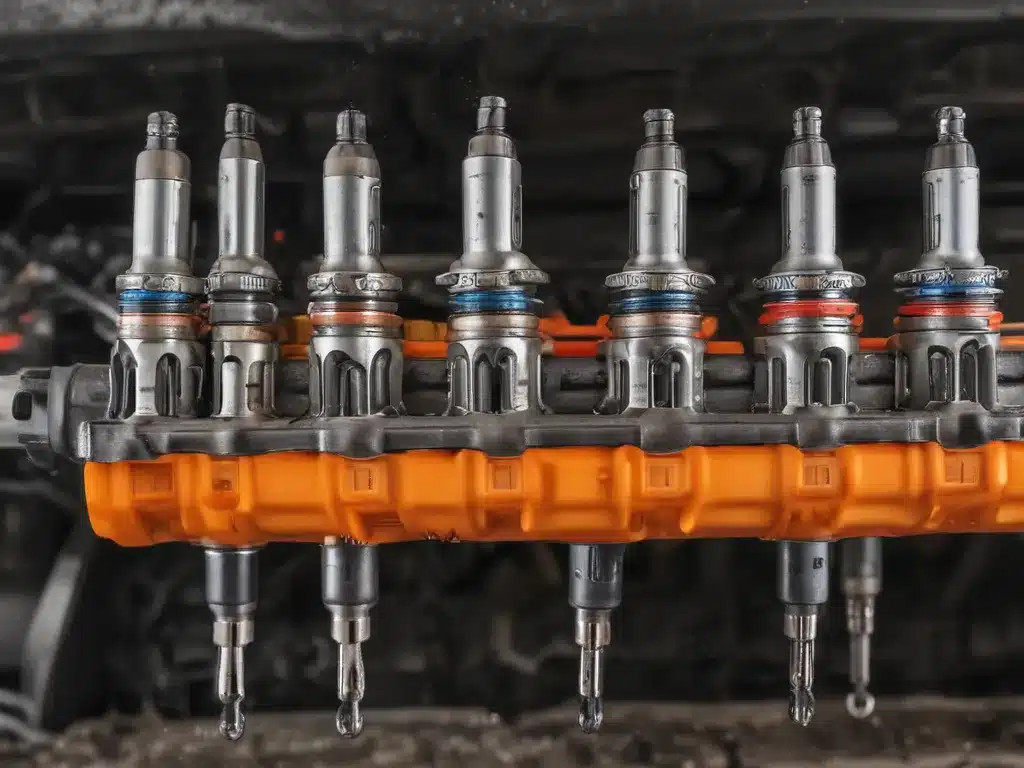
Understanding the Fuel Injector’s Role in Your Vehicle
As the heart of your vehicle’s engine, the fuel injector plays a crucial role in ensuring your car runs smoothly and efficiently. This small but mighty component is responsible for delivering the precise amount of fuel required for combustion, making it essential for optimal engine performance.
But what happens when your fuel injector starts to malfunction? Well, my friend, that’s where the real adventure begins! In this comprehensive guide, I’ll take you on a deep dive into the world of fuel injector diagnosis and replacement. We’ll explore the common signs of a failing injector, the steps to properly diagnose the issue, and the best practices for a successful replacement.
Identifying the Signs of a Problematic Fuel Injector
First things first, let’s talk about the telltale signs that your fuel injector might be on its last legs. One of the most obvious indicators is a noticeable drop in your vehicle’s fuel efficiency. If you’re finding yourself at the gas station more often than usual, it could be a sign that your fuel injector is not delivering the optimal fuel-air mixture.
Another common symptom is a rough or uneven idle. When a fuel injector is malfunctioning, it can cause the engine to stumble or vibrate, making for a less-than-smooth driving experience. And let’s not forget about that pesky check engine light – if it’s illuminated on your dashboard, it could be your fuel injector’s way of saying, “Hey, I need some attention over here!”
Diagnosing the Fuel Injector Issue
Okay, now that we’ve identified the potential red flags, it’s time to roll up our sleeves and get down to the nitty-gritty of diagnosis. The first step is to perform a thorough inspection of the fuel injector itself. Look for any signs of wear, damage, or clogging – these could all be contributing to the problem.
Next, it’s time to break out the trusty multimeter and test the fuel injector’s electrical components. By checking the resistance, voltage, and current, you can determine whether the injector is receiving the proper signals from the engine control unit (ECU). If the readings are outside the recommended range, it’s a clear indication that the fuel injector needs to be replaced.
But wait, there’s more! Don’t forget to check the fuel pressure and flow as well. Low fuel pressure or restricted flow can also lead to a malfunctioning fuel injector, so be sure to test these crucial parameters too.
Replacing the Fuel Injector: A Step-by-Step Guide
Alright, you’ve done your due diligence and confirmed that the fuel injector needs to be replaced. Time to roll up those sleeves and get to work!
Before you dive in, make sure you have all the necessary tools and parts on hand. You’ll need a new fuel injector, of course, as well as any gaskets, seals, or O-rings that might need to be replaced in the process.
Once you’ve gathered your supplies, it’s time to get to work. Start by disconnecting the fuel line and electrical connector from the old injector. Be careful – those fuel lines can be under high pressure, so take the necessary precautions to avoid any nasty surprises.
Next, gently remove the injector from its mounting. This may require a special tool, so be sure to consult your vehicle’s service manual for the proper technique. With the old injector out of the way, it’s time to install the new one.
Carefully align the new injector and secure it in place. Reconnect the fuel line and electrical connector, and don’t forget to replace any gaskets or seals that may have been damaged during the process.
Finally, turn the engine on and check for any leaks or signs of improper installation. If everything checks out, you’re ready to hit the road and enjoy the smooth, efficient performance of your newly replaced fuel injector.
The Importance of Regular Fuel Injector Maintenance
But wait, there’s more! To keep your fuel injector in top-notch condition, it’s crucial to maintain it on a regular basis. This means regularly cleaning the fuel system, using high-quality fuel, and addressing any issues that may arise as soon as possible.
Neglecting your fuel injector can lead to a whole host of problems, from decreased fuel efficiency to engine misfiring and even complete failure. So, be sure to stay on top of your vehicle’s maintenance schedule and don’t hesitate to seek professional help if you’re unsure about anything.
Wrapping Up: The Key to Fuel Injector Longevity
Alright, my friends, we’ve covered a lot of ground in this fuel injector extravaganza. From understanding the critical role of this component to properly diagnosing and replacing it, you’re now armed with the knowledge to keep your vehicle running like a well-oiled machine.
Remember, regular maintenance and vigilance are the keys to fuel injector longevity. Keep an eye out for those telltale signs, don’t be afraid to get your hands dirty, and always prioritize safety when working on your vehicle. And hey, if you ever need a little extra help, don’t hesitate to reach out to the pros at https://autooilandfluid.com/ – they’re always happy to lend a hand (or a wrench)!


